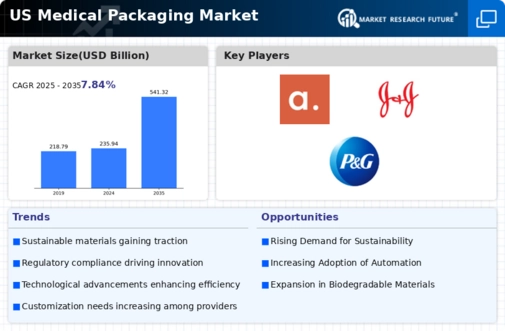Growth of Biopharmaceuticals
The biopharmaceutical sector is experiencing rapid growth, significantly impacting the medical packaging market. With the rise of biologics and biosimilars, there is an increasing need for specialized packaging that ensures product stability and integrity. The biopharmaceutical market is projected to reach $500 billion by 2026, which will likely drive demand for advanced packaging solutions. These solutions must address challenges such as temperature control and contamination prevention. As a result, companies are investing in innovative materials and designs to cater to this expanding segment, thus acting as a key driver for the medical packaging market.
Rising Demand for Home Healthcare
The increasing trend towards home healthcare is reshaping the medical packaging market. As more patients receive treatment at home, the need for safe, user-friendly packaging solutions becomes paramount. This shift is driven by an aging population and a preference for at-home care, which is expected to grow by 7% annually. Packaging must not only protect the product but also facilitate ease of use for patients and caregivers. Consequently, manufacturers are innovating to create packaging that meets these needs, thereby expanding their market share. The demand for home healthcare solutions is likely to propel growth in the medical packaging market.
Focus on Patient-Centric Packaging
The medical packaging market is witnessing a shift towards patient-centric designs prioritizing user experience. This trend is driven by the need for packaging that is not only functional but also intuitive for patients. Features such as easy-open designs, clear labeling, and ergonomic shapes are becoming essential. As healthcare providers aim to enhance patient adherence to medication regimens, the demand for such packaging is expected to increase. Market Research Future indicates that patient-centric packaging could lead to a 15% improvement in medication compliance rates. Therefore, this focus on patient-centric solutions is a vital driver in the medical packaging market.
Regulatory Compliance and Standards
The medical packaging market is heavily influenced by stringent regulatory requirements imposed by agencies such as the FDA. Compliance with these regulations ensures that packaging materials are safe and effective for medical use. As the industry evolves, manufacturers must adapt to new standards, which may include enhanced labeling, traceability, and safety features. This compliance protects patients and fosters trust in medical products. The market is projected to grow as companies invest in meeting these standards, with an estimated increase of 5% in compliance-related expenditures over the next few years. Thus, regulatory compliance serves as a critical driver in the medical packaging market.
Technological Integration in Packaging Solutions
The integration of advanced technologies into packaging solutions is transforming the medical packaging market. Innovations such as smart packaging, which includes features like RFID tracking and temperature monitoring, are becoming increasingly prevalent. These technologies enhance product safety and provide real-time data, which is crucial for supply chain management. The market for smart packaging is expected to grow by 10% annually, indicating a strong trend towards technological adoption. As healthcare providers seek to improve efficiency and patient safety, the demand for technologically advanced packaging solutions is likely to rise, making it a significant driver in the medical packaging market.














Leave a Comment